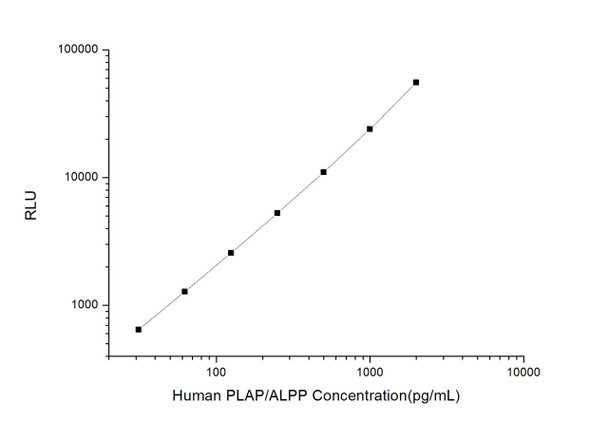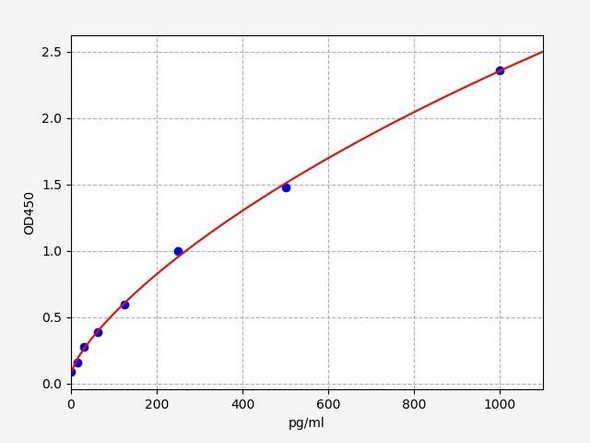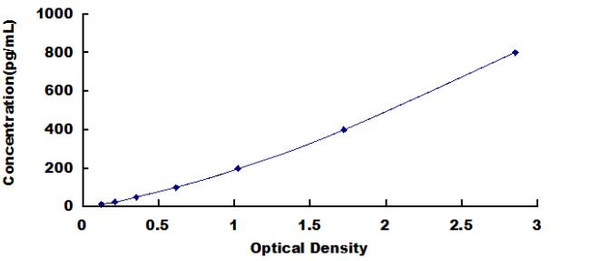Human Cell Biology ELISA Kits 5
Human PLAP/ALPP (Placental Alkaline Phosphatase) CLIA Kit (HUES01075)
- SKU:
- HUES01075
- Product Type:
- ELISA Kit
- ELISA Type:
- CLIA Kit
- Size:
- 96 Assays
- Sensitivity:
- 18.75pg/mL
- Range:
- 31.25-2000pg/mL
- ELISA Type:
- Sandwich
- Reactivity:
- Human
- Sample Type:
- Serum, plasma and other biological fluids
- Research Area:
- Cell Biology
Description
| Assay type: | Sandwich |
| Format: | 96T |
| Assay time: | 4.5h |
| Reactivity: | Human |
| Detection method: | Chemiluminescence |
| Detection range: | 31.25-2000 pg/mL |
| Sensitivity: | 18.75 pg/mL |
| Sample volume: | 100µL |
| Sample type: | Serum, plasma and other biological fluids |
| Repeatability: | CV < 15% |
| Specificity: | This kit recognizes Human PLAP/ALPP in samples. No significant cross-reactivity or interference between Human PLAP/ALPP and analogues was observed. |
This kit uses Sandwich-CLIA as the method. The micro CLIA plate provided in this kit has been pre-coated with an antibody specific to Human PLAP/ALPP. Standards or samples are added to the appropriate micro CLIA plate wells and combined with the specific antibody. Then a biotinylated detection antibody specific for Human PLAP/ALPP and Avidin-Horseradish Peroxidase (HRP) conjugate are added to each micro plate well successively and incubated. Free components are washed away. The substrate solution is added to each well. Only those wells that contain Human PLAP/ALPP, biotinylated detection antibody and Avidin-HRP conjugate will appear fluorescence. The Relative light unit (RLU) value is measured spectrophotometrically by the Chemiluminescence immunoassay analyzer. The RLU value is positively associated with the concentration of Human PLAP/ALPP. The concentration of Human PLAP/ALPP in the samples can be calculated by comparing the RLU of the samples to the standard curve.
| UniProt Protein Function: | ALPP: There are at least four distinct but related alkaline phosphatases: intestinal, placental, placental-like, and liver/bone/kidney (tissue non-specific). The first three are located together on chromosome 2 while the tissue non-specific form is located on chromosome 1. The product of this gene is a membrane bound glycosylated enzyme, also referred to as the heat stable form, that is expressed primarily in the placenta although it is closely related to the intestinal form of the enzyme as well as to the placental-like form. The coding sequence for this form of alkaline phosphatase is unique in that the 3' untranslated region contains multiple copies of an Alu family repeat. In addition, this gene is polymorphic and three common alleles (type 1, type 2 and type 3) for this form of alkaline phosphatase have been well characterized. [provided by RefSeq, Jul 2008] |
| UniProt Protein Details: | Protein type:Cell surface; Membrane protein, integral; Cofactor and Vitamin Metabolism - folate biosynthesis; Phosphatase (non-protein); Motility/polarity/chemotaxis; Membrane protein, GPI anchor; EC 3. 1. 3. 1 Chromosomal Location of Human Ortholog: 2q37 Cellular Component: cell surface; plasma membrane; integral to membrane Molecular Function:zinc ion binding; alkaline phosphatase activity; magnesium ion binding Biological Process: dephosphorylation |
| NCBI Summary: | There are at least four distinct but related alkaline phosphatases: intestinal, placental, placental-like, and liver/bone/kidney (tissue non-specific). The first three are located together on chromosome 2 while the tissue non-specific form is located on chromosome 1. The product of this gene is a membrane bound glycosylated enzyme, also referred to as the heat stable form, that is expressed primarily in the placenta although it is closely related to the intestinal form of the enzyme as well as to the placental-like form. The coding sequence for this form of alkaline phosphatase is unique in that the 3' untranslated region contains multiple copies of an Alu family repeat. In addition, this gene is polymorphic and three common alleles (type 1, type 2 and type 3) for this form of alkaline phosphatase have been well characterized. [provided by RefSeq, Jul 2008] |
| UniProt Code: | P05187 |
| NCBI GenInfo Identifier: | 94721246 |
| NCBI Gene ID: | 250 |
| NCBI Accession: | NP_001623. 3 |
| UniProt Secondary Accession: | P05187,P05188, P06861, Q53S78, Q96DB7, |
| UniProt Related Accession: | P05187 |
| Molecular Weight: | 57,954 Da |
| NCBI Full Name: | alkaline phosphatase, placental type preproprotein |
| NCBI Synonym Full Names: | alkaline phosphatase, placental |
| NCBI Official Symbol: | ALPP |
| NCBI Official Synonym Symbols: | ALP; PALP; PLAP; PLAP-1 |
| NCBI Protein Information: | alkaline phosphatase, placental type; Regan isozyme; glycerophosphatase; alkaline phosphomonoesterase; placental alkaline phosphatase 1; alkaline phosphatase Regan isozyme |
| UniProt Protein Name: | Alkaline phosphatase, placental type |
| UniProt Synonym Protein Names: | Alkaline phosphatase Regan isozyme; Placental alkaline phosphatase 1 |
| Protein Family: | Phosphatase |
| UniProt Gene Name: | ALPP |
| UniProt Entry Name: | PPB1_HUMAN |
As the RLU values of the standard curve may vary according to the conditions of the actual assay performance (e. g. operator, pipetting technique, washing technique or temperature effects), the operator should establish a standard curve for each test. Typical standard curve and data is provided below for reference only.
| Concentration (pg/mL) | RLU | Average | Corrected |
| 2000 | 50461 60981 | 55721 | 55693 |
| 1000 | 22895 25053 | 23974 | 23946 |
| 500 | 11797 10267 | 11032 | 11004 |
| 250 | 4825 5763 | 5294 | 5266 |
| 125 | 2698 2518 | 2608 | 2580 |
| 62.5 | 1329 1293 | 1311 | 1283 |
| 31.25 | 631 717 | 674 | 646 |
| 0 | 27 29 | 28 | -- |
Precision
Intra-assay Precision (Precision within an assay): 3 samples with low, mid range and high level Human PLAP/ALPP were tested 20 times on one plate, respectively.
Inter-assay Precision (Precision between assays): 3 samples with low, mid range and high level Human PLAP/ALPP were tested on 3 different plates, 20 replicates in each plate.
| Intra-assay Precision | Inter-assay Precision | |||||
| Sample | 1 | 2 | 3 | 1 | 2 | 3 |
| n | 20 | 20 | 20 | 20 | 20 | 20 |
| Mean (pg/mL) | 108.69 | 295.36 | 710.94 | 118.51 | 279.33 | 692.59 |
| Standard deviation | 9.88 | 26.02 | 71.09 | 11.69 | 24.55 | 62.06 |
| C V (%) | 9.09 | 8.81 | 10.00 | 9.86 | 8.79 | 8.96 |
Recovery
The recovery of Human PLAP/ALPP spiked at three different levels in samples throughout the range of the assay was evaluated in various matrices.
| Sample Type | Range (%) | Average Recovery (%) |
| Serum (n=5) | 92-106 | 99 |
| EDTA plasma (n=5) | 88-104 | 95 |
| Cell culture media (n=5) | 90-104 | 95 |
Linearity
Samples were spiked with high concentrations of Human PLAP/ALPP and diluted with Reference Standard & Sample Diluent to produce samples with values within the range of the assay.
| Serum (n=5) | EDTA plasma (n=5) | Cell culture media (n=5) | ||
| 1:2 | Range (%) | 96-109 | 92-106 | 93-107 |
| Average (%) | 102 | 100 | 100 | |
| 1:4 | Range (%) | 103-118 | 89-101 | 101-120 |
| Average (%) | 110 | 94 | 110 | |
| 1:8 | Range (%) | 103-116 | 90-102 | 87-102 |
| Average (%) | 109 | 95 | 93 | |
| 1:16 | Range (%) | 90-103 | 101-113 | 90-105 |
| Average (%) | 95 | 107 | 97 |
An unopened kit can be stored at 4°C for 1 month. If the kit is not used within 1 month, store the items separately according to the following conditions once the kit is received.
| Item | Specifications | Storage |
| Micro CLIA Plate(Dismountable) | 8 wells ×12 strips | -20°C, 6 months |
| Reference Standard | 2 vials | |
| Concentrated Biotinylated Detection Ab (100×) | 1 vial, 120 µL | |
| Concentrated HRP Conjugate (100×) | 1 vial, 120 µL | -20°C(shading light), 6 months |
| Reference Standard & Sample Diluent | 1 vial, 20 mL | 4°C, 6 months |
| Biotinylated Detection Ab Diluent | 1 vial, 14 mL | |
| HRP Conjugate Diluent | 1 vial, 14 mL | |
| Concentrated Wash Buffer (25×) | 1 vial, 30 mL | |
| Substrate Reagent A | 1 vial, 5 mL | 4°C (shading light) |
| Substrate Reagent B | 1 vial, 5 mL | 4°C (shading light) |
| Plate Sealer | 5 pieces | |
| Product Description | 1 copy | |
| Certificate of Analysis | 1 copy |
- Set standard, test sample and control (zero) wells on the pre-coated plate and record theirpositions. It is recommended to measure each standard and sample in duplicate. Note: addall solutions to the bottom of the plate wells while avoiding contact with the well walls. Ensuresolutions do not foam when adding to the wells.
- Aliquot 100 µL of standard solutions into the standard wells.
- Add 100 µL of Sample / Standard dilution buffer into the control (zero) well.
- Add 100 µL of properly diluted sample (serum, plasma, tissue homogenates and otherbiological fluids. ) into test sample wells.
- Cover the plate with the sealer provided in the kit and incubate for 90 min at 37 °C.
- Aspirate the liquid from each well, do not wash. Immediately add 100 µL of BiotinylatedDetection Ab working solution to each well. Cover the plate with a plate seal and gently mix. Incubate for 1 hour at 37 °C.
- Aspirate or decant the solution from the plate and add 350 µL of wash buffer to each welland incubate for 1-2 minutes at room temperature. Aspirate the solution from each well andclap the plate on absorbent filter paper to dry. Repeat this process 3 times. Note: a microplatewasher can be used in this step and other wash steps.
- Add 100 µL of HRP Conjugate working solution to each well. Cover with a plate seal andincubate for 30 min at 37 °C.
- Aspirate or decant the solution from each well. Repeat the wash process for five times asconducted in step 7.
- Add 100 µL of Substrate mixture solution to each well. Cover with a new plate seal andincubate for no more than 5 min at 37 °C. Protect the plate from light.
- Determine the RLU value of each well immediately.






